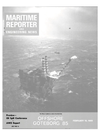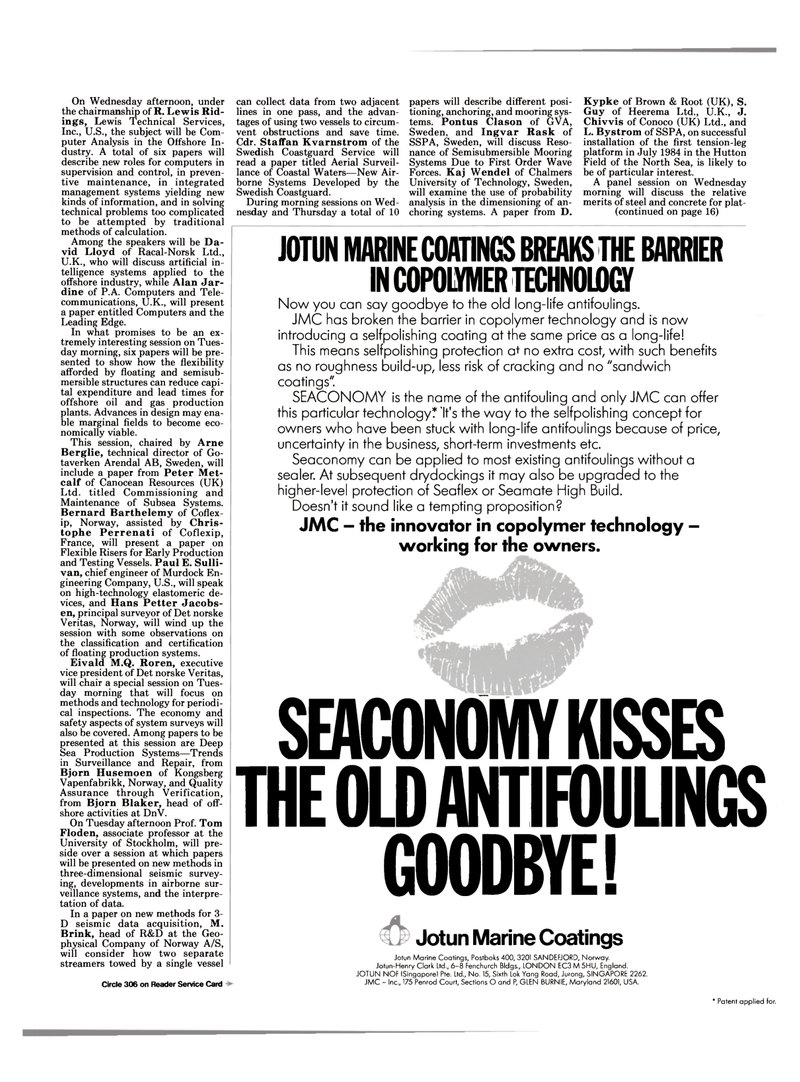
Page 13: of Maritime Reporter Magazine (February 15, 1985)
Read this page in Pdf, Flash or Html5 edition of February 15, 1985 Maritime Reporter Magazine
On Wednesday afternoon, under the chairmanship of R. Lewis Rid- ings, Lewis Technical Services,
Inc., U.S., the subject will be Com- puter Analysis in the Offshore In- dustry. A total of six papers will describe new roles for computers in supervision and control, in preven- tive maintenance, in integrated management systems yielding new kinds of information, and in solving technical problems too complicated to be attempted by traditional methods of calculation.
Among the speakers will be Da- vid Lloyd of Racal-Norsk Ltd.,
U.K., who will discuss artificial in- telligence systems applied to the offshore industry, while Alan Jar- dine of P.A. Computers and Tele- communications, U.K., will present a paper entitled Computers and the
Leading Edge.
In what promises to be an ex- tremely interesting session on Tues- day morning, six papers will be pre- sented to show how the flexibility afforded by floating and semisub- mersible structures can reduce capi- tal expenditure and lead times for offshore oil and gas production plants. Advances in design may ena- ble marginal fields to become eco- nomically viable.
This session, chaired by Arne
Berglie, technical director of Go- taverken Arendal AB, Sweden, will include a paper from Peter Met- calf of Canocean Resources (UK)
Ltd. titled Commissioning and
Maintenance of Subsea Systems.
Bernard Barthelemy of Coflex- ip, Norway, assisted by Chris- tophe Perrenati of Coflexip,
France, will present a paper on
Flexible Risers for Early Production and Testing Vessels. Paul E. Sulli- van, chief engineer of Murdock En- gineering Company, U.S., will speak on high-technology elastomeric de- vices, and Hans Petter Jacobs- en, principal surveyor of Det norske
Veritas, Norway, will wind up the session with some observations on the classification and certification of floating production systems.
Eivald M.Q. Roren, executive vice president of Det norske Veritas, will chair a special session on Tues- day morning that will focus on methods and technology for periodi- cal inspections. The economy and safety aspects of system surveys will also be covered. Among papers to be presented at this session are Deep
Sea Production Systems—Trends in Surveillance and Repair, from
Bjorn Husemoen of Kongsberg
Vapenfabrikk, Norway, and Quality
Assurance through Verification, from Bjorn Blaker, head of off- shore activities at DnV.
On Tuesday afternoon Prof. Tom
Floden, associate professor at the
University of Stockholm, will pre- side over a session at which papers will be presented on new methods in three-dimensional seismic survey- ing, developments in airborne sur- veillance systems, and the interpre- tation of data.
In a paper on new methods for 3-
D seismic data acquisition, M.
Brink, head of R&D at the Geo- physical Company of Norway A/S, will consider how two separate streamers towed by a single vessel
Circle 306 on Reader Service Card can collect data from two adjacent lines in one pass, and the advan- tages of using two vessels to circum- vent obstructions and save time.
Cdr. Staflfan Kvarnstrom of the
Swedish Coastguard Service will read a paper titled Aerial Surveil- lance of Coastal Waters—New Air- borne Systems Developed by the
Swedish Coastguard.
During morning sessions on Wed- nesday and Thursday a total of 10 papers will describe different posi- tioning, anchoring, and mooring sys- tems. Pontus Clason of GVA,
Sweden, and Ingvar Rask of
SSPA, Sweden, will discuss Reso- nance of Semisubmersible Mooring
Systems Due to First Order Wave
Forces. Kaj Wendel of Chalmers
University of Technology, Sweden, will examine the use of probability analysis in the dimensioning of an- choring systems. A paper from D.
Kypke of Brown & Root (UK), S.
Guy of Heerema Ltd., U.K., J.
Chivvis of Conoco (UK) Ltd., and
L. Bystrom of SSPA, on successful installation of the first tension-leg platform in July 1984 in the Hutton
Field of the North Sea, is likely to be of particular interest.
A panel session on Wednesday morning will discuss the relative merits of steel and concrete for plat- continued on page 16)
JOTUN MARINE COATINGS BREAKS THE BARRIER IN COPOLYMER TECHNOLDGY
Now you can say goodbye to the old long-life antifoulings.
JMC has broken the barrier in copolymer technology and is now introducing a selfpolishing coating at the same price as a long-life!
This means selfpolishing protection at no extra cost, with such benefits as no roughness build-up, less risk of cracking and no "sandwich coatings".
SEACONOMY is the name of the antifouling and only JMC can offer this particular technology? 'It's the way to the selfpolishing concept for owners who have been stuck with long-life antifoulings because of price, uncertainty in the business, short-term investments etc.
Seaconomy can be applied to most existing antifoulings without a sealer. At subsequent drydockings it may also be upgraded to the higher-level protection of Seaflex or Seamate High Build.
Doesn't it sound like a tempting proposition?
JMC - the innovator in copolymer technology - working for the owners.
SEACONOMY KISSES THE OLD ANTIFOULINGS
GOODBYE!
Jotun Marine Coatings
Jotun Marine Coatings, Postboks 400, 3201 SANDEFJORD, Norway.
Jotun-Henry Clark Ltd., 6-8 Fenchurch Bldgs., LONDON EC3 M 5HU, England.
JOTUN NOF (Singapore) Pte. Ltd., No. 15, Sixth Lok Yang Road, Jurong, SINGAPORE 2262.
JMC - Inc., 175 Penrod Court, Sections O and P, GLEN BURNIE, Maryland 21601, USA. * Patent applied for.

 12
12

 14
14
